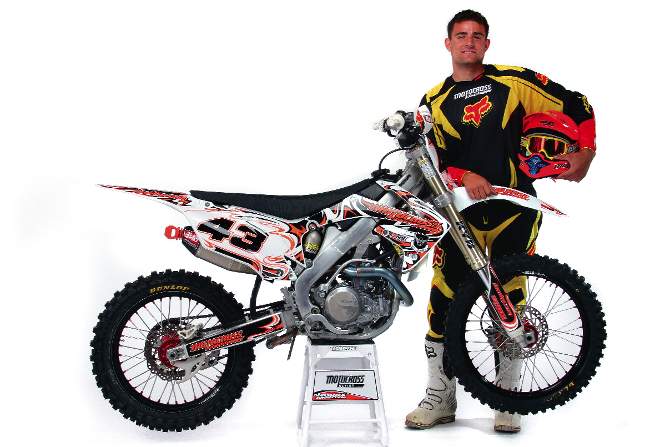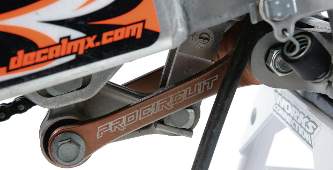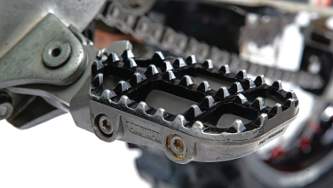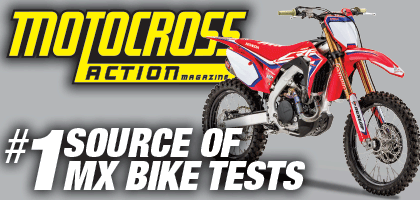LIVING WITH & LOVING LIFE WITH THE 2010 HONDA CRF450 (OKAY, THERE WAS A LITTLE HATE INVOLVED)

There was a ton of buzz about the totally redesigned 2009 Honda CRF450. Some of it was good, and some of it was bad. As a magazine test rider, I have the privilege of being among the first to ride new bikes, and I had quickly established myself on the negative side. You may have been shocked by MXA‘s criticism of the 2009 Honda CRF450, but it didn’t come as a total surprise to me. The CRF450 was really great in 2007 and 2008, but I thought Honda was beginning to make some mistakes. In 2008, Honda mounted the HPSD steering damper and reduced the offset to 22mm for sharper turning. To me, this was a step in the wrong direction, and I compensated by returning to the 24mm offset triple clamps from the 2007 CRF450 and drop-kicking the steering damper.
So when I went to the technical session on the 2009 CRF450 and heard that they were steepening the head angle, moving the front wheel back, changing the offset to 20mm and depending more on the HPSD damper, I left the meeting with a sense of dread.
 |
| Different offset triple clamps are often touted, but the best chassis mod is a longer linkage arm like Pro Circuit’s. It helps the handling by balancing out the front and rear of the CRF450. |
MY FELLOW PUMPKIN-HEADS AND I SPENT TONS OF TIME TESTING EVERY CRF450 CHASSIS MOD IMAGINABLE. SOME THINGS HELPED, OTHERS WERE TERRIBLE, BUT THROUGH TRIAL AND ERROR WE FIGURED OUT WHAT WORKED.
Oh, don’t get me all wrong, the lightweight, fuel-injected CRF450 wasn’t all bad, but it did have a lot of issues that MXA has chronicled very thoroughly. My fellow pumpkin-heads and I spent tons of time testing every CRF450 chassis mod imaginable in the last year and a half. Some things helped, others were terrible, but through trial and error we figured out what worked.
So when we started testing the 2010 Honda CRF450, we had a much better understanding of its shortcomings, because it was largely identical to the 2009 CRF450. Add to that the fact that I was one of the few MXA test riders who felt that there was still room for improvements with the CRF450, and you can understand why I signed up to run the 2010 CRF450 post-test project. I decided to pretend that I owned the bike, set it up just for me, and employ the most cost-effective mods to make living with the CRF450 as successful as possible.
Here are my tips for living with and loving the 2010 version of the CRF450.
(1) Chassis: The CRF450 geometry is aggressive. It’s eager to turn, and since the bike is lightweight, it’s really fun to throw around. Conversely, it oversteers, knifes and suffers from headshake. Handling is my biggest complaint about the bike, partially because it’s the most difficult aspect of a bike to fix (compared to the engine or suspension), and partially because it feels wrong at the wrong times?and that’s a volatile combination.
(2) Acclimate. As much as I hate to say it, you have to acclimate to riding the 2010 Honda CRF450. Face it, the CRF450 is different. Unless you have the dinero to build a new frame, it will never be very stable. In short, I changed my riding style to work with its quirks.
(3) Free fixes. Although a lot of CRF450 mods are expensive, there are plenty of cheap things that you can do to get more stability. I slide the forks up and down depending on the track conditions. I run a couple millimeters more race sag to balance out the chassis. I stiffen up the forks a little beyond the comfort zone to calm the brake dive down. I even tried moving the rear wheel as far back as possible, but all that did was move more weight forward?and that is not something the CRF450 needs.
(4) Shock linkage. Many people think that aftermarket shock linkages have something to do with the rear suspension. They don’t! It’s not for the shock; it’s for the chassis. Trying to run excessive sag or less high-speed compression to drop the rear is a bad tradeoff. It essentially ruins the shock’s performance in an attempt to level out the chassis. By changing to a Pro Circuit, Factory Connection or Ride Engineering linkage, you lower the chassis in the rear (which provides a lot more options in front and rear balance). The linkage is cake you can eat.
(5) Stiffer fork springs. The 2010 has a bit firmer valving in the forks, but this is just a Band-Aid fix. If you want to race, as opposed to play ride, you will need stiffer fork springs.
 |
| Honda’s 32-spoke rear wheels are susceptible to damage over the long haul. These 36-spoke Rad wheels are as strong as an ox. |
(6) Revalve. Getting the suspension dialed in is a big confidence booster. Finding a company (especially a local one) that will work with you to get the setup you want is a treasure. I selected Factory Connection because I had tested their Honda suspension on several pro riders’ bikes. They do good work. Best of all, they worked with me through multiple revalves and spring changes to get exactly what I was looking for.
(7) Triple clamps. Opinions vary on this subject, but I’ve tried 22mm clamps and 24mm clamps and didn’t think the improvement justified the cost (of the two different offsets, I had the best luck with 24mm). I run the stock OEM 20mm offset on the 2010.
(8) Steering damper. In my philosophy book, adding a hydraulic door hinge to the front end is a sign that something is inherently wrong in the bike’s geometry. Plus, I don’t like the dragging feel, so I turn the adjuster all the way out and leave it for the desert guys.
When a manufacturer comes out with a totally new bike, there are always bugs, but the 2009 Honda had enough to justify calling an exterminator. For 2010, Honda fixed a durability issue with the decompression lever on the camshaft, but other issues still needed to be addressed.
When a manufacturer comes out with a totally new bike, there are always bugs, but the 2009 Honda had enough to justify calling an exterminator. For 2010, Honda fixed a durability issue with the decompression lever on the camshaft, but other issues still needed to be addressed.
(1) Clutch. Honda’s OEM four-spring design is terrible. A full Wiseco or Hinson six-spring unit (or the new Hinson single-spring unit) is the best solution, but it isn’t the cheapest. On our 2010, I’ve been upgrading the plates and springs only, settling for a modest improvement in feel and durability. I’ve tested a DP kit, a Barnett kit and OEM stuff with stiffer Hinson springs. Stiffer clutch springs are worth the $50 cost.
(2) Basket. Based on other Honda riders’ experiences, I’ve been keeping an eye on the stock basket for chips or grooving. If I see any signs of wear, I’ll call Barnett. Their stainless insert basket is bulletproof. If it does wear, they’ll replace the inserts for free.
(3) Oil. On one of our 2009s, we had gasoline contaminate the engine oil regularly. It hasn’t happened with our 2010, but I sniff the dipstick before every ride anyway.
(4) Plastic. Honda saved weight by going minimal on every part, but in my opinion they went too far with the plastic. I destroyed the radiator shrouds when they hooked on my boots in corners. They bent and then they snapped. MXA test riders who wear knee braces have cracked the shroud plastic just by banging their carbon-clad knees against the bike. Additionally, the front number plate can also succumb to cannon-sized roost. The most logical fix was to switch to UFO plastic. It holds up to punishment better, and DeCal Works will mount their graphics on new UFO plastics for you (which is good, because I was running out of ways to trick John Basher into mounting my graphics for me).
(5) Wheels. The stock Honda wheels are excellent quality and very light. Too light, in my opinion, to be thrashed during week-in and week-out test riding. I had RAD Manufacturing build up a super durable set of wheels using their hubs and DID Dirtstar ST-X rims. I like having these two sets of wheels to quickly test different tires and as a backup option.
(6) Timing covers. We have broken the ignition covers on both the 2009 and 2010 CRF450s. Hairline cracks spread out across the face of the cover and leak oil. New covers are expensive. I keep a tube of JB Weld in the toolbox just in case.
We have tried everything from race gas to high-compression pistons, to flywheel weights and everything else on the latest-generation CRF450. Three things stand out, functionally and cost-wise. Here they are in order of importance.
(1) Pipe. The stock powerband is flat on top. It makes a modicum of horsepower (nowhere near what Kawasaki and KTM produce), but quits pulling at 8200 rpm. MXA has tested a bunch of aftermarket pipes. The Yoshimura exhaust was my favorite. It improved the top half of the rpm range without sacrificing much (if any) of the bottom.
(2) Throttle body. Injectioneering does a modification to the throttle body that improves the first quarter turn of the throttle and eliminates flameout. I was skeptical before I tried it, but now Injectioneering owner Wade Wilcox is my BFF. This mod makes a shocking difference.
(3) Cam. The CRF450 engine is a “Unicam” design, so installing a cam is notably cheaper and easier than on other brands. I was happy with the performance of the Yoshimura cam (read the test in the May 2010 issue of MXA), and I’m sure that virtually every aftermarket cam is a worthwhile improvement.
The CRF450’s fuel injection has positives and negatives. On the positive side, it makes the bike very responsive at the first crack of the throttle, and it runs great down low. It makes the bike run better on cold mornings and on trips to higher-elevation tracks. It also enables more precise tuning, if you have the equipment and know-how. Negatives include a tendency to make the power flatten out on top, and flameout when chopping the throttle. And, the low-end bark is a negative for some. In fact, enough complaints were registered in 2009 that Honda tamed the mapping on the 2010 CRF450.
Racers should learn to be careful what they wish for, because our 2010 was 1-1/2 ponies slower than the 2009. We blame the mapping (because it’s the only thing they changed). The following are the modifications I made in an effort to get the ponies back into the stable.
 |
 |
| Pro Taper’s footpegs are arched across the top and come with different height platforms. MXA runs the minus 5mm platforms. | The Yoshimura exhaust gives the CRF450 exactly what it needs: mid-and-up power. The oxygen sensor bung in the head pipe allows for more exact fuel mapping. |
(1) Programming tool. My first modification was supposed to be to the 2010 CRF450’s mapping, but first I had to make modifications to our PGM-FI tuning tool. It turns out that the 2009 programmer will not work on the 2010 model because the connector, programmer and software are different on the 2010 model. Honda sent us the new software and an adaptive sub-harness (which costs about $100). On the positive side, the 2010 is way easier to connect it to.
(2) 2009 black box. Since the 2009 was faster, and since it’s impossible to duplicate the 2009 mapping in a 2010 bike with the new software program, we figured we would simply put a 2009 black box into our 2010 bike. It worked. The downside was that we simply turned the 2010 Honda CRF450 into a 2009 CRF450. No big deal. We used last year’s software to put in the map we ran on the older model.
(3) Mapping. Not everybody has access to last year’s black box, so I spent a lot of time trying to duplicate the 2009 feel by playing with ignition and fuel settings on the 2010 bike. I was able to cross-reference my new 2010 maps with the old 2009 maps. I made progress with different advanced timing and leaner or richer maps, but I was never able to get the fast and aggressive feel of the 2009 black box.
As an MXA test rider, I’m always jumping from one bike to another. I often race two or three different bikes at the same race. Luckily, I’m not picky about lever position or other picayune things. However, there are a couple of bike interface issues that make a big difference for me. Here’s what I changed on the Honda CRF450.
As an MXA test rider, I’m always jumping from one bike to another. I often race two or three different bikes at the same race. Luckily, I’m not picky about lever position or other picayune things. However, there are a couple of bike interface issues that make a big difference for me. Here’s what I changed on the Honda CRF450.
(1) Footpegs. Honda must have a million old footpegs in a warehouse in Japan, because they refuse to update them. The stockers collect mud and don’t grip boots very well. Pro Taper’s pegs resist mud jamming in the pivot, (although on a deep rut day I still run Acerbis footpeg protectors) and offer 5mm lower, slightly arched platforms.
(2) Handlebars. I’m 6’2″, so taller handlebars make standing up much more comfortable for me. Tag Metals’ CR-Hi bend offers the same dimensions as the stock Renthal bars, but with more rise and sweep, which means less hunching and less sitting down over bumps. Incidentally, the Tag bars are much cheaper than a Tempurpedic or a chiropractor.
(3) Brakes. The OEM Honda brakes are as good as they ever were, but unfortunately they aren’t at the top of the class anymore (KTM’s are). The front gets mushy, and the small rear pads fade. An oversized rotor is the ultimate setup, but I prefer to keep the stock rotor and upgrade to a Galfer braided steel brake line. This is a notable improvement, and with fresh fluid and a clean rotor, performance is more than satisfactory. The best solution for the rear is simply to bleed and clean often. Different fluid and gimmicky reservoir extenders and such don’t do much to prevent fade.
(4) Graphics. DeCal Works T-7 semi-custom job makes the bike unique?nobody else has these graphics. The wrecking crew spent a lot of time getting the bike where I want it, but I don’t want the bike to show those hours.
(5) Hour meter. Keeping on top of oil changes, clutch maintenance and brake inspection is more important on the Honda than other bikes. I installed a TTO digital tachometer and hour meter. It’s small, has cool mounting options, and remembers peak rpm.
(6) Front tire. Having a predictable front tire is important. I have been enjoying the Dunlop MX31 when there is roostable dirt on the track.
If I showed up to the racetrack and was assigned by MXA to race a bone-stock 2010 Honda CRF450, I would do it?but I wouldn’t like it. This bike rolled off the assembly line with a lot of work left to be done. After two years of testing, I found that with the right mods, the 2010 Honda CRF450 can be the right bike.






Comments are closed.